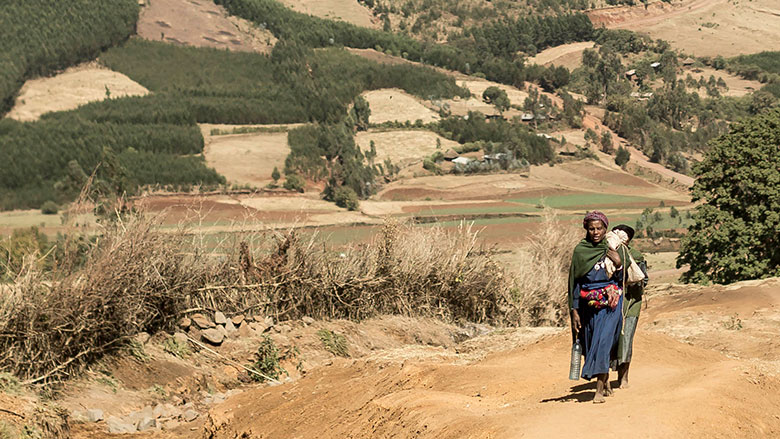ADDIS ABABA, April 16, 2020 – The new Ethiopia Poverty Assessment finds that the national poverty rate has declined amid challenging climatic conditions, and recommends areas for further attention to sustain and deepen gains.
The assessment, Harnessing Continued Growth for Accelerated Poverty Reduction, identifies the key drivers of progress across the country, which include the agriculture sector, but notes that growth has been uneven between urban and rural areas. Although the report was finalized before COVID-19 (coronavirus) pandemic, the results can inform the government’s and development partners’ actions to cushion the impacts of the crisis on the poorest and most vulnerable members of society.
According to the analysis, poverty decreased from 30% of the population in 2011 to 24% in 2016, the year of the most recent survey on household living standards. However, the report points out that the poorest 10% of the population did not experience any growth in income since 2005. As a result, poor people in 2016 were on average poorer than the poor in 2005.
Gains overall, and agriculture will remain important
“Poverty reduction was particularly strong in cities and towns, in line with strong overall economic growth, but was relatively weak in the less connected rural areas of the country,” said Arden Finn, World Bank Economist and co-author of the report. “A major arising issue is the need to transition to non-farm livelihoods, with the more than two million annual new entrants to the Ethiopian labor market increasingly making a living from non-farm wage employment and self-employment. Additionally, the disparity in access to education between rural and urban households widens the gap in wage earning opportunities and therefore needs to be addressed.”
Although the services sector contributed to poverty reduction and is likely to increase as structural transformation gains pace in the country, the report notes the agriculture sector remains by far the most important. This implies that although agriculture is declining as a share of gross domestic product, its dominance in the livelihoods of poor people means that improvements in input markets, mechanization and land tenure will be needed to drive poverty reduction for at least the next decade.
Patterns of progress were different in urban and rural areas
“Poverty in urban areas fell from 26% in 2011 to 15% in 2016. Conversely, progress was more modest in rural areas, with a decrease in poverty from 30% to 26% over the same period,” said Carolyn Turk, World Bank Country Director for Ethiopia, Eritrea, Sudan and South Sudan.
Increased urban poverty reduction was the result of solid growth in employment and increasing returns to self-employment, according to the report.
In rural areas, poverty reduction was driven by improved infrastructure and connectivity, as well as good agricultural growth. Within agriculture, the report highlights the move to cash crops and the usage of improved seeds which has had poverty-reducing effects. Given that improved seeds were used on only 6% of cultivated land, the report recommends improving the timely availability and use of improved seeds is a straightforward policy action.
Another key driver of rural poverty reduction was the expansion of the flagship Productive Safety Net Program (PSNP). The poverty assessment notes that the contribution of the PSNP to poverty reduction could further be enhanced by better aligning needs with beneficiary numbers, improving geographical targeting, and harmonizing the different food security programs and interventions.
The assessment identifies three, key challenges to address to sustain progress:
- Ensure that the poorest and most vulnerable members of the population are also able to enjoy the benefits of continued economic growth. The poorest 10% of Ethiopia’s population has not experienced any growth in consumption since 2005. Many of these households are chronically poor, and tend to be larger, less educated, and have fewer productive assets than other households.
- Improve human capital outcomes for young Ethiopians. Less than 20% of children from very poor households finish primary school and less than 25% receive all basic vaccinations. Although the country has made solid progress on the supply-side of public service delivery, usage of those services by the poorest is however lagging, which is partly explained by financial barriers and opportunity costs. Incentives to extremely poor rural households to keep children in school or complete critical health actions may be important policy tools for breaking the intergenerational poverty trap.
- Ensure that vulnerable children are not left behind. Children from poor households and children in rural areas have far worse access to key services like education and clean water, and are at risk of being left behind (compared to children in urban areas or from better-off households). If left unaddressed, this can be expected to drive up economic inequality sharply in the coming decades, negatively affecting inclusive growth.
